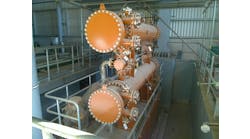A climate-friendly way to produce hydrocarbons from carbon dioxide extracted from bioethanol manufacturing and from hydrogen generated by water electrolysis has undergone successful piloting, report Finnish scientists.
The pilot started in October and ran for almost five weeks at the biorefinery in Jokioinen, Finland, of St1, Gothenburg, Sweden. The 10,000-L/yr refinery uses liquid starch from enzyme production as its main feedstock and produces liquid animal feed, soil improvers, fertilizers and carbon dioxide.
A proton exchange membrane (PEM) generated the hydrogen for the pilot. The PEM contains 12 electrolyzer cells operating at 65–70°C, all housed inside a 10-ft-square, 5-mt container.
“The electrolyzer produces 4 Nm3/hr of hydrogen,” notes Janne Kärki, senior scientist, renewable energy processes, at the VTT Technical Research Centre of Finland, Helsinki. VTT is working with St1 on the pilot as part of its strategic research initiative to find solutions for mitigating climate change.
“This is then passed into a Fischer-Tropsch synthesis unit which consumes 2 Nm3/hr of carbon dioxide from the ethanol plant and produces 3–5 L/d of liquid hydrocarbons and 6–9 L/d of solid hydrocarbons,” he adds.
The product breakdown consisted roughly of 20% hydrocarbon gases (C1–C4); 25% gasoline fraction (C5–C12); 15% diesel fraction (C13–C18); 40% heavier fraction (C18+), mainly waxes; plus small amounts of n-alcohols and olefins.
The whole process resides within a mobile synthesis unit (Figure 1).
Figure 1. Pilot plant at Finnish biorefinery produced hydrocarbons from carbon dioxide and hydrogen. Source: St1.
The pilot has shown that the process integration was successful and that carbon dioxide utilization is possible in this way at the Jokioinen site, stress the researchers.
“However, due to an unfortunate technical accident, we had to cancel the demonstration prematurely. The synthesis unit was damaged and fixing it would have been too time-consuming. This accident doesn’t reflect the core technology development itself, as this was due to some design faults that can be taken care of in future activities,” explains Kärki.
The plan now is to build a next-generation synthesis system on the same scale as the damaged pilot plant. “We found that this is a suitable scale for different on-site testing purposes. We also have smaller, laboratory-scale developments for even easier testing. We’re constantly looking for new industrial co-operation possibilities in these areas, too,” he says.
The pilot is part of a two-year project called Bioeconomy+, which is co-financed by the European Regional Development Fund, VTT and a number of other partners.


